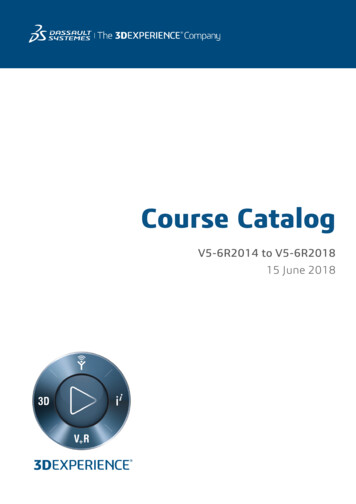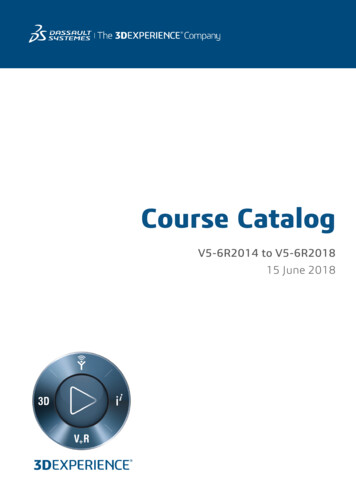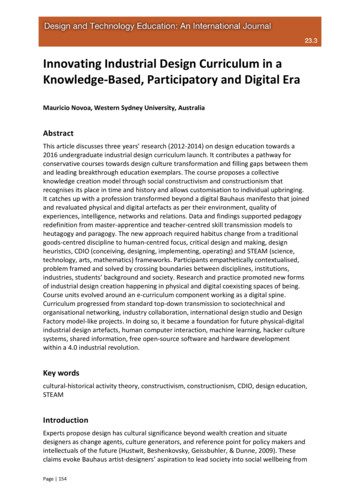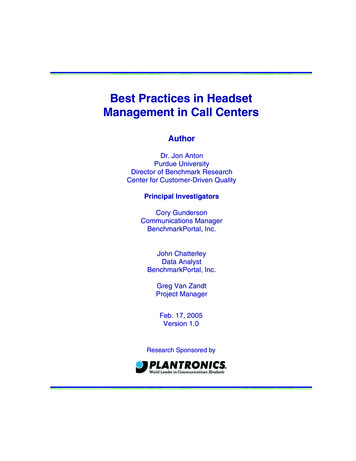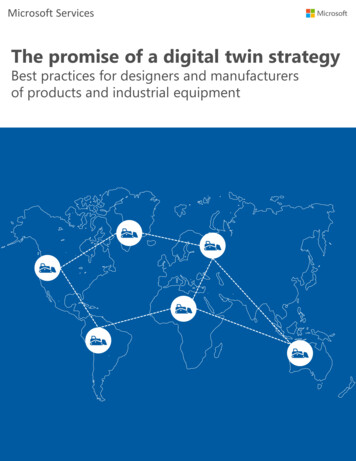
Transcription
Microsoft ServicesThe promise of a digital twin strategyBest practices for designers and manufacturersof products and industrial equipment
ContentsIntroduction . 3Digital transformation: An imperative . 4-5The digital twin revolution . 6-7Digital twin architecture for an integrated enterprise offering . 8The impact of a digital twin strategy . 9-12Three stages of the digital twin journey .13-16Microsoft solutions and technologies for your digital twin strategy . 17-19Get started today 20-21References 2202
IntroductionDesigners and manufacturers ofproducts are experiencing a majortransformation as digital technologiesare reshaping what is possible, fromachieving new levels of operationalefficiency to creating new serviceofferings and beyond with innovativebusiness models.At Microsoft, we believe designers andmanufacturers can benefit from creatinga digital twin strategy and platformfor the business to host innovative newofferings and achieve a holistic approachto transformation.In this paper, we define the scenariosthat will have the biggest impact on yourbusiness and show you how Microsoft isuniquely positioned to help you planand execute a digital twin strategy.03
Digital transformation:An imperativeToday’s digital transformation is changing the priorities of nearly every enterprise. In the future, allcompanies will be digital companies—not only creating smart connected products, but buildingservices to capture new business opportunities and engage with the value chain differently to meettheir evolving expectations.This kind of transformation can be incredibly difficult, particularly as traditional businesses move fromtried-and-true product design strategies and manufacturing processes that have worked for decades.The definition of a product today is vastly different from one created 3-4 years ago. There is agrowing expectation that products will not solve for only a discrete business or lifestyle issue butrather will add and derive value from the ecosystem where it exists and functions.The challenge extends beyond just designing a product that combines the best attributes of physicaland digital worlds. Product lifecycles are changing. Products must not only get to market faster and atthe right time, they must also evolve and improve to sustain value for both the designer/manufacturerand owner/operator. As a consequence, many manufacturers are challenged to keep pace. This meansthat the transformation is not limited just to product design and definition, but rather significantlyimpacts the way products are manufactured, assembled, delivered and maintained.04
Digital transformation:An imperativeContinuedIn reality, Industry 4.0 is a journey. Manymanufacturers have to work with equipment thatspans decades of investment, remain at the forefrontof cybersecurity practices, and develop and attractthe skilled workforce of the future. This doesn’thappen overnight; digital transformation is aninvestment and commitment to constant evolution.To get ahead of the curve, organizations are makingdigital transformation a priority as CEOs expectdigital revenue to double in the next five years. IDCsays that by 2020, 70% of manufacturers will putoperations at the forefront of these projects1. Theintelligent factory is quickly becoming a reality as40% of operational processes will be self-healing andself-learning by 20222. At the same time, IoT-basedsensing and cognitive situational awareness willcontinue to improve the speed of operations. IDCestimates this will create 30% improvements in thecycle times of impacted critical processes by 20183.Designers and manufacturers that can achieve digitalexcellence will thrive in this new world. To do so, theymust create a consistent digital information threadthroughout the enterprise and value chain. Thisfounding principle is enabled and enhanced bycloud- and edge-based technologies and capabilitiesthat can facilitate potential for gains in engineering,supply chain, manufacturing, final assembly and test.The digital twin is strategy that can turn this digitalinformation thread into real value.05
The digital twin revolutionOne of Gartner’s Top 10 Strategic Technology Trends for 20174, a digital twin is a virtual model of aprocess, product, production asset or service. Sensor-enabled and IoT-connected machines anddevices, combined with machine learning and advanced analytics can be used to view the device'sstate in real time. When combined with both 2D and 3D design information, a digital twin canvisualize the physical world and provide a method to simulate electronic, mechanical, and combinedsystem outcomes.This pairing of virtual and physical worlds allows monitoring of systems and analysis or simulation ofdata to head off problems to prevent downtime, optimize overall operations to increase uptime, andeven develop new services for the future. These can be unique to each customer but can also be usedto intelligently record and compare a global fleet view of insights that can improve internal processessuch as design engineering, supply chain management, quality processes, manufacturing operationsand field services. To be successful, a digital twin must be intelligent, collaborative, interactive,immersive, and fully contextual within the OEM’s enterprise.* Image source: https://www.cat.com/en 0000223.html06
The digital twin revolutionContinuedThe digital twin model is not new. NASA was the first to experiment with the precursor to a digitaltwin—pairing technology—in the early days of space exploration. The formal concept of a digital twinwas first introduced in 2002 as an information mirroring model by Dr. Michael Grieves5. In 2013, EricTuegel, AFRL/RQVS, of the United States Airforce Research Laboratory, progressed the definition ofDigital Twin with “Airframe Digital Twin.”6 The definition included an integrated architecture spanningdesign, test and evaluation, manufacturing and assembly, sustainment and maintenance, repair andoverhaul, and the creation of a lifecycle-wide probabilistic support system for decision making.What is new today is the method by which you can facilitate a digital twin strategy based on advancedtechnologies like IoT, cognitive services and cloud computing to form the basis to develop and deploydynamic applications and services that cater to enterprise and customer needs. Within the lastdecade, the concept of a digital twin has been mostly used for product design and simulation byutilizing a data-driven 3D digital companion. Most recently, data and advanced analytics have enableddigital twin technology to do more than simply mirror key processes within physical assets. Now adigital twin strategy can use machine learning to predict outcomes based on historical data andalgorithms specific to parts, systems, subassemblies and assemblies that further consider lifecyclestates from as-designed to as-manufactured to as-maintained. Today predictive analytics andadvanced visualization allow us to explore or identify new opportunities and business models.07
Digital twin architecture for anintegrated enterprise offeringDeveloping a digital twin strategy should always begin with the intended business benefits,outcomes, and impact on people, practices, and processes. It is not simply enough to validate thatthe technology functions. Often many digital strategies fail to meet expectations because they arefocused on proof-of-technology versus proof-of-value. Once value is well articulated, the technologycan be proven through use cases with measurable results. As an example, if the goal of a digital twinstrategy is to increase equipment availability in the field, the scope of the use case can spanequipment health insights through to optimal scheduling of parts and field engineers. Themeasurement of success can then take the form of total availability sustained validated by thenumber of maintenance incidents mitigated, elapsed time for replacement part availability, andreduction in time taken to deploy resources in the field.The approach to this use case can be the analysis of equipment telemetry such as onboarddiagnostics or analytical processing of historical performance data, but represented as a relativehealth measurement easily identifiable by a field engineer. This representation could be purely datadriven and displayed through a dashboard or a holographic indicator shown within the context ofthe actual equipment as it operates.The manifestation of value could be the creation of a customer facing digital twin service thatmanages availability of their equipment through automated insights and expert assistance from themanufacturer.08
The impact of a digital twinstrategyWhat would it mean to your organization if you could mitigate equipment failure, streamline yourfactory operations and processes, increase operational efficiency, and perform enhanced productdevelopment? A digital twin strategy offers you exceptional ways to achieve these objectives,allowing you to transform your business by applying virtual lessons to the physical world to uncovernew opportunities and business models.A digital twin strategy is most effective when applied to low-volume, highly-configured productswhere you need detailed information to quickly respond to changing conditions, particularly forthings like asset optimization and preventive maintenance. The insights you gain will enable you tooperate at peak performance because you can maintain your equipment in such a way where itnever fails. The end result? You can lower operating expenses and increase efficiencies as you extendthe life of your equipment and optimize its daily performance.Another effective approach is to expand the scope of your digital twin strategy from a single objector piece of equipment to build a digital twin model of your supply chain or entire factory. This willallow you to have complete visibility across all levels of your plant operations and processes—all theway down to how individual machines and people are interconnecting in real time and even externalfactors. The combination of this information gives you very personalized, actionable information.09
The impact of a digital twinstrategyContinuedAs you bring in this kind of intelligence, you can drive significant levelsof growth and efficiency across your manufacturing organization by:Creating new customer and enterprise value through personalizedservice. A digital twin strategy serves as the ultimate customer serviceapplication for your business. Real-time data shows you how yourcustomers are operating and maintaining their products. These insightsallow you to further optimize equipment operation and ensureimproved uptime and availability. This has the potential to completelychange the way your business manages customer support today as youmove to more personalized service, versus a one-size-fits-all approach.New value-added digital services and revenue streams are also nowpossible as you transform the products you take to market and createnew customer experiences by leveraging digital twin insights. You canextend capabilities such as customer support and field service, as wellas develop upgradable opportunities for customers tailored for optimalperformance of their specific equipment. This can drive unique revenueopportunities for OEMs and resellers as well.Driving product quality and innovation. Digital twin simulations, usingreal-world data learned from how existing equipment, processes, andproducts perform over time, allow you to experiment with designiterations, make more informed design and engineering decisions, andenhance the overall product roadmap. For example, by simulating theoutcome of changing different components within a specific product,you could determine if that change will allow you to meet your qualitygoal or will merely increase the cost of the product with no othermeasurable gains. This data allows you to influence and validate newprototypes and bring better, more innovative products to market faster.Pioneering breakthroughs are more achievable and cost-effective, aswell as better aligned with the full product life cycle.10
The impact of a digital twinstrategyContinuedPreventing breakdowns before they occur. You can reduce productioncosts and downtime by using a digital twin simulation to adjust productperformance, safely postpone non-regulated maintenance events ifneeded, or even eliminate problems before they occur. Servicetechnicians can manipulate equipment digitally in real-time, or visualizeproblems ahead of a job to optimize the operation of existingequipment and perform preventative maintenance. Experts can supporttechnicians in remote locations by using immersive and rich virtual,augmented or Windows Holographic experiences to help troubleshootmore complex issues by visualizing complete systems including hiddenor obstructed parts and assemblies. Ultimately, a digital twin strategyallows you to reduce or mitigate devastating failures and have moreoperational flexibility and efficiency.Reinventing knowledge-sharing for employees. Your digital twinstrategy can allow your experts to explain complex scenarios visually,with 3D and 2D representations of real-world operational parametersand characteristics. These types of tools are essential for manufacturersto democratize skills and knowledge-sharing when facing an agingworkforce and an approaching skills gap between new or lessexperienced employees. A digital twin strategy also enables employeesin both professional and trade roles to build skills while at work,opening up new possibilities through advanced and contextualknowledge sharing. Digital twin capabilities can have a significantimpact in terms of providing proactive guidance that can span theenterprise by increasing innovation during the design phase through toimproving field service personnel safety during maintenanceprocedures. Together with Windows Holographic devices such asHoloLens, your workforce can be more efficient and will always have theright knowledge and right skills in the right place, at the right time.11
The impact of a digital twinstrategyContinuedIn all cases, products and processes are fixed faster, equipment stays working longer, manufacturerscan develop better products, and the workforce is more efficient. The key is the ability to use realworld operational data to make smart, informed changes that provide the best resolution in realtime or scheduled—whether data is captured from just one customer or many. The digital interfaceof the twin allows you to simulate many different scenarios—eliminating costly physical trial anderror—before you put the final change in place.Implementing a digital twin strategy will soon be non-negotiable for most manufacturers. As thefoundation for your connected products and services, it is a critical path to enabling asset or processlifecycle management, intercompany collaboration, flexible vertical integration, and end-to-end reengineering. Manufacturers that do not keep up with this innovation will be quickly left behind.Next, let’s look at how you can get started with a digital twin strategy today, best practices fordriving innovation, and examples from leading enterprises that are differentiating their business witha digital twin strategy.12
Three stages of the digitaltwin journeyThe digital twin journey begins with a data-centric strategy that can evolve to three stages of maturity.You can start realizing the benefits of a digital twin strategy at the very first stage. As you continueyour evolution, your business will be transformed as you use a digital twin strategy as a competitiveadvantage to meet the changing needs of customers, achieve new levels of operational efficiency,drive product innovation, and capture new business opportunities. As your business evolves, so willyour digital twin strategy.Stage 1: Remote monitoring of smart,connected products with predictiveanalyticsFor many businesses, the journey to a digital twinstrategy starts with the basics: smart connectedproducts and remote monitoring. A digital twinstrategy allows you to store and monitor productconfiguration details and performance informationunique to each customer, all while being fleet-aware.Having access to this device data provides asignificant amount of value, with no requirement toconnect to any visual content such as 3D or 2Dcomputer aided design (CAD) content. You canleverage interactive data visualization dashboardssuch as those found in Microsoft Power BI. In thisfirst step, you have still accomplished a digital twinenvironment because the data is unique to thecustomer, however there remains opportunity toexpand and enhance capabilities by extending intopredictive analytics, connected field service, andultimately into engineering.This is where Microsoft’s cloud platform provides acomprehensive set of capabilities that span device toservice to application, essentially creating a uniquebond between the customer and the enterprise.Rolls-Royce and Microsoft collaborate tooffer advanced operational intelligence toairlinesRolls-Royce is leading the industry by mergingphysical and digital worlds to gain insights intomaintenance planning, fuel management, andoverall fleet health—ultimately helping airlinesrun at reduced costs with longer lifespans fortheir aircraft. The company’s Trent XWB turbofanjet engine is a significant data provider in theoverall airline ‘data platform’ that uses predictiveanalytics and customized intelligence to helpairlines operate at peak performance and utmostsafety, as well as ensure the highest level of costsavings. This is a new level of predictiveintelligence that could not be realized previouslydue to lack of access to either the rightinformation or tools to process the informationefficiently. Rolls-Royce can achieve theseimpressive results by using historical and realtime data feeds—without contextual 3Dengineering model visualization capabilities.13
Three stages of the digitaltwin journeyContinuedStage 2: A platform for deep insightsAfter remote monitoring is in place, the nextstep is to build a platform to facilitate yourdigital twin strategy, one that gives you theactual virtual representation of the physicalproduct or system, with a deep view into themechanical, electrical, and digital components.Windows Holographic devices such asMicrosoft HoloLens give you a powerful way tovisualize this data and interact with thefunctionality and performance of the productand components.It is this platform that gives you a completepicture of your equipment’s genealogy. You willnot only be able to see the physical view of theproduct as it is operating, but you can also seefactors such as how it was designed, how itwas manufactured, and how it is actually beingmaintained. This data gives you a completelynew level of insight to accelerate innovation,increasing the overall value of the productthrough the development of new services forcustomers, improved operations of the currentproduct, and new functionality for futureproduct versions.Sandvik Coromant uses predictive analytics tooptimize serviceTo take its services to the next level, Microsofthelped Sandvik Coromant develop a scalableservice model that integrates all elements of theproduction flow—people, machines, tools anddata—to deliver an unprecedented level of fieldservice. The model was developed with apredictive analytics solution that leverages AzureIoT Suite, Cortana Intelligence, and Dynamics365, allowing the company to scale its expertiseto its global customer base without the need toadd manpower or reduce quality of service. Withthis technology, Sandvik Coromant can nowprovide services that help customers make moreinformed decisions and more easily calculate thefinancial return on a new machining tool. Thattranslates to additional revenue, more satisfiedcustomers, and greater flexibility in how itstechnical experts connect with customers.14
Three stages of the digitaltwin journeyContinuedTetra Pak’s technology keeps food and drinkflowing safely from farm to tablePackaging pioneer Tetra Pak is using a digital twinstrategy to advance its services operations. Havingstarted with the utilization of remote monitoringcapabilities, the company is now employing new digitaltools that enable its cloud-connected machines topredict exactly when equipment needs maintenance,averting many breakdowns. Tetra Pak is also leveragingthe power of HoloLens to develop a virtual servicebusiness which allows senior technicians to guideremote technicians for more than 8,000 packagingmachines in plants across the globe, even when aproject is thousands of miles away.thyssenkrupp innovates with Microsoft HoloLensand Skypethyssenkrupp has integrated Microsoft HoloLens andSkype into its operations to improve efficiency forservice technicians. These workers can now visualizepotential causes of issues before they go to a job site,work hands-free while on the job, and engage withremote experts who can virtually walk them throughsolutions to fix potentially very complex problems.Work that used to take one to two hours is nowtaking less than 20 minutes. thyssenkrupp is also usingHoloLens and Azure to design and deliver custombuilt stair lift home solutions with an even higherstandard of customer experience, and at a faster pacethan ever before.15
Three stages of the digitaltwin journeyContinuedStage 3: Smarter machines for a smarter businessThe final and most innovative stage is a fully integrated system that couples a real-time simulationplatform with natural human interaction. By applying advanced artificial intelligence technologies suchas cognitive services to your digital twin strategy, you now have a value-added layer of insight thatcould not be achieved from sensor data alone. These capabilities can automatically identify and reportan issue, simulate numerous possible outcomes, and recommend the best resolution.Using Microsoft Cognitive Services, you can also add voice interface capabilities that allow you to talkto your machine’s digital twin environment. You can ask for a status report or request a performancechange, and then visualize all possible outcomes to determine final action. Furthermore, advancedaudio and visual processing can identify conditions and interpret specific outcomes. For example, aresonant frequency may be identified as irregular deterioration of bearings or warping of a spindle.Additionally, by processing images from still frames or video, foreign object intrusion may beidentified at its source or human movement can be detected to prevent accidents. These advancedmethods of learning from machine, audio, and visual data can form the basis for self-diagnosing andself-healing capabilities as well as smart human-machine collaboration.A value-added strategy is to factor in additional information pieces critical to understanding thecustomer environment, such as call center logs, maintenance events, and reports that are not storedor recorded by a smart, connected product. This assimilates all of the machine-based and humanbased data and circumstances around what the customer is reporting within their specificenvironment in order to see the complete picture.As you increase the quality of interactions between machines and humans, your machines learn andbecome more intelligent. They can perform such functions as self-optimization based on a learningsystem and report that back to help you enhance future design or improve customer services. You canalso learn about potential quality issues or procedural problems in the way the product was built. Asyour machines become smarter, your business becomes smarter.The concept of an artificially intelligent product is now within reach for manufacturers, made possibleby catalysts such as cognitive services, which will help to drive the next wave of innovation.16
Microsoft solutions andtechnologies for your digitaltwin strategyMicrosoft has the solutions and technologies that work together seamlessly to deliver acomprehensive and connected digital twin platform: for the physical product, for your customer, andfor your enterprise in an end-to-end manner.We offer Windows Holographic devices that can visualize digital virtual worlds, augment the realworld with camera-based imaging, or place 3D and 2D content in the real world with holograms viaMicrosoft HoloLens, which all enable visualization of 3D product data in the real world. Our MicrosoftAzure Big Compute cloud platform and services can seamlessly simulate design choices by runningFinite Element Analysis (FEA) or Simulation Program with Integrated Circuit Emphasis (SPICE)applications. Our Microsoft Azure IoT Suite can collect data from connected devices and feedparameters into any simulation application together with real-world conditions. Additionally, withWindows 10, applications can easily send 3D data to 3D printers to create parts on-demand. This canbe extremely helpful for prototyping solutions for a customer or mitigating any supply chain delays byprinting temporary part replacements quickly. Our cloud-based services can also connect devices touse machine learning to correct and sharpen analytics. Our rich cognitive services such as BOTs andlanguage and image processing train equipment to progressively learn from its own use.17
Microsoft solutions andtechnologies for your digitaltwin strategyContinuedOur ready solutions can help you get started today –Connected Field ServiceThe Microsoft Connected Field Service solution allows manufacturers to learn about problems beforethe customer does and solve them at the smallest cost to the organization. In a simple scenario, wherean abnormality is detected, a sensor sends an alert off to an Azure IoT Hub. This triggers aconfigurable workflow process within Dynamics 365 for Field Service, ensuring a first-time fix. Thisproactive approach improves customer satisfaction and resource productivity by catching issues andtroubleshooting them remotely—before they significantly impact your business.Predictive MaintenanceThe Microsoft Predictive Maintenance solution gives you better visibility into equipment status, lettingyou resolve issues before they disrupt your business. Monitor your assets in near-real time bycollecting data through Azure IoT Suite. This allows you to create automatic alerts and actions, such asremote diagnostics, maintenance requests, and other workflows. Then perform historical analysis ofyour data and predict when you need to service equipment.Remote MonitoringWith the Microsoft Remote Monitoring solution, you can monitor assets located nearly anywhere fromafar. The solution helps you understand equipment conditions, enabling you to provide over-the-wireupdates and fine-tune processes. To optimize business processes over the long term, the solutionapplies analytics techniques, like machine learning, to your data. The smart system performs inoperation analysis to find correlations across multiple data streams, letting you improve costs, uptime,and product quality. You can also leverage new predictive maintenance programs to perform historicalanalysis of your data and resolve issues before they disrupt your business.Big Compute for Visualization & SimulationUsing Microsoft Azure, you can increase the frequency and speed of engineering simulations, analyses,and visualizations to optimize product designs for performance, safety, and manufacturing usinghyper-scalability in the cloud. Quickly provision high-performance computing clusters in the cloud toreplace or scale up capacity as either the primary resource or as an on-demand, burst capability.18
Microsoft solutions andtechnologies for your digitaltwin strategyContinuedDigital TwinMicrosoft’s digital twin approach brings the power of immersive, holographic capabilities to deepenand accelerate interactivity across the value network and help make your digital transformation areality. Learn how new value networks can be created that multiply the potential for gains inoperational efficiency and the development of new business models.Connected OperationsWith Microsoft Connected Operations, you can empower your employees to engage with yourcustomers, so you can transform your products, optimize your operations, and find new sources ofrevenue.Microsoft HoloLens brings your digital twin strategy to lifeWith Windows Holographic devices, the digital twinenvironment takes on an expanded role in manufacturing: theability to blend physical and digital into 3D. It’s one thing tocreate a digital prototype, it’s another to see a holographichologram of equipment digitally brought to life byincorporating physical and digital worlds.Microsoft HoloLens is a powerful visualization tool that takesyour digital twin strategy to this new level by allowing you todo things that were previously impractical or even impossible.You now have an entirely new way to visualize relevant data inthe context of the real world, solve complex tasks, not tomention save costs and downtime in factories or plants.19
Get started todayYour digital twin strategy is more than just about technology. No longer is it an engineeringoverhead for your organization; it is a powerful business strategy that can accelerate your digitaltransformation. To be truly successful, you must thread digital twin capabilities into your business asa strategic asset to enable new opportunities.Most businesses are already at the first stage of their digital twin strategy with smart, connectedproducts and remote monitoring. As you continue
system outcomes. This pairing of virtual and physical worlds allows monitoring of systems and analysis or simulation of . measurement of success can then take the form of total availability sustained validated by the . never fails. The end result? You can lower operating expenses and



